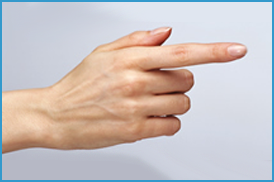Trigger Finger
Trigger finger or trigger thumb is a condition that causes one of the fingers or the thumb to get caught in a bent position, then to quickly snap back into a straight position, like a trigger snaps back after release. If left untreated, trigger finger can cause stiffness and pain, and may eventually lead to an inability to completely straighten the finger.
Trigger finger is caused by an inflammation or swelling of the tendons in the finger, which are surrounded by a protective covering called the tendon sheath. Because there is a lubricating membrane surrounding the joint, tendons usually glide easily through the sheath. However, the tendon can become inflamed or swollen at the base of the finger, resulting in a nodule. Bending the finger or thumb may pull the nodule through the sheath where is “catches” on the edge, resulting in the finger popping back into place with the nodule snaps back through the sheath. If the nodule gets permanently trapped behind the tendon sheath the finger can become stuck in the flexed position.
Causes of Trigger Finger
Trigger finger is common in people who perform repetitive gripping actions or prolonged, strenuous grasping. It is more common in women and tends to occur between 40 and 60 years of age but can occur in anyone at any age. It can also be the result of medical conditions that affect tissue, such as rheumatoid arthritis or diabetes.
Trigger Finger Symptoms
Early symptoms of trigger finger can include stiffness, a popping sensation when you move the finger or tenderness or a bump at the base of the finger. As the condition progresses it can lead to the finger catching or locking in a bent position, and ultimately it can lead to a finger or thumb that cannot be straightened out.
Trigger finger more commonly occurs in your dominant hand, and most often affects your thumb or your middle or ring finger. More than one finger may be affected at a time, and both hands might be involved. Triggering is usually more pronounced in the morning, while firmly grasping an object or when straightening your finger.
Treatment of Trigger Finger
Trigger finger can usually be treated through conservative methods that include one or more of the following:
- Resting the hands
- Applying cold packs
- Anti-inflammatory medication
- Corticosteroid injections
- Trigger finger exercises
- Occupational therapy
Trigger Finger Surgery
Typically non-surgical treatment is recommended for trigger finger, but severe cases may require surgery. The procedure is typically done as outpatient surgery, and most patients go home the same day. Trigger finger surgery involves making a small incision in the palm which allows the surgeon access to the tendon sheath. The sheath is cut, allowing the nodule to move through the sheath.
Most people are able to move their fingers immediately after surgery although it is common to have soreness in the palm. Recovery is typically complete within a few weeks although it can take up to six months for all swelling and stiffness to go away. Exercise and physical therapy may also be required to help loosen up stiffness and restore function to the finger.
If you are suffering from trigger finger or hand pain, contact Dr. Rehman for a comprehensive evaluation and consultation. As with most medical conditions, early detection, awareness and a comprehensive treatment plan is the most effective way to combat the effects of conditions like trigger finger.
Macomb County Trigger Finger Doctor: 586.532.0803

Hand Conditions We Treat:
· Carpal Tunnel Syndrome
· CMC and Thumb Arthritis
· DeQuervain’s Disease
· Dupuytrens Contracture
· Fingernail Infection
· Ganglion Cysts
· Hand, Wrist, Finger Fracture
· Hand, Wrist or Finger Pain
· Tendonitis
· Tendons and Nerves
· Tennis Elbow
· Trigger Finger
· Ulnar Nerve Neuropathy
· Dislocations
· Sprains and Strains
· Phalanx & Fingertip Injuries
· Crush Injuries
· Tissue Loss Amputations
· Extensor Tendons
· Flexor Tendons
· Scar Management
· Nerve Compression
· Joint Replacements
· Sports Injuries
· Replants
· Any Hand or Wrist Injury



